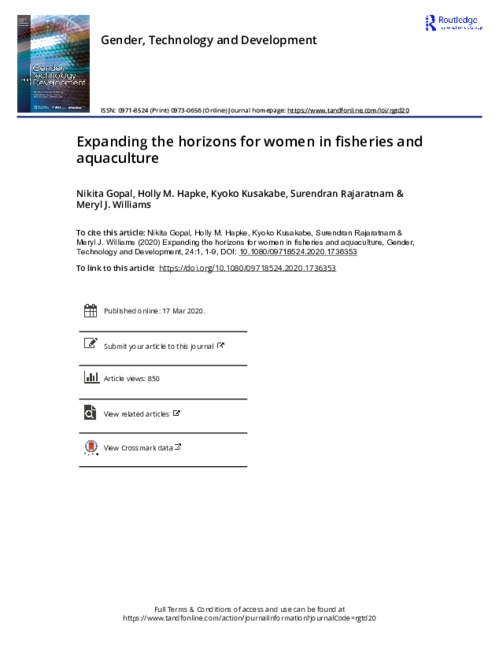Expanding the horizons for women in fisheries and aquaculture

Women are present in all phases of fish production, processing and distribution, and contribute to the generation of wealth, the preservation of aquatic ecosystems, and the maintenance of households and communities in rural and coastal regions. They make up half the workforce and play a prominent role in fisheries and aquaculture economies around the world (Food and Agriculture Organization of the United Nations [FAO], 2018; The World Bank, 2012). Yet their work goes unrecognized in official statistics, sector policies and development programs. The FAO only collects statistics on the primary fish production sector, in which women make up only 14% of workers, as estimated from returns by a limited number of member countries. FAO does not collect data on the secondary sector that employs many more women, and statistics on small scale fisheries where women are more numerous than in industrial fishing are relatively poor (FAO, 2018). Global and most national fisheries policies are gender-blind. The 2014 Voluntary Guidelines for Securing Sustainable Small-Scale Fisheries (VGSSF) in the Context of Food Security and Poverty Eradication was the first major fisheries instrument to incorporate gender equality (Biswas, 2017). The most relevant Sustainable Development Goal (SDG), number 14, which focuses on Life Below Water is one of the few SDGs not to contain gender targets (United Nations Entity for Gender Equality and the Empowerment of Women [UN Women], 2018). Women face many inequities in wages and access to productive resources, technology and markets. Despite decades of research documenting women’s economic contributions, collective action to advance women’s interests and rights, and more recent institutional efforts to mainstream gender inclusion in fisheries development programs, achieving gender equality and women’s empowerment in this sector remains a challenge (Gopal et al., 2017). This Special Issue advances previous research that focused more on the gender division of labor in fisheries and aquaculture economies toward a wider and deeper analysis of how gender constructs and unfolds in multiple dimensions of the sector. The seven papers in this Special Issue of Gender, Technology and Development (GTD) on Gender and Fisheries focus on gender and gender relations contextualized within changing fisheries and aquaculture settings. The resulting technological and institutional changes come from different drivers, such as climate change, competitive trading relations, newly introduced fishing gears, new resource management regimes, and the need for suitable feminist research methodologies. The papers examine questions about technology, innovation, organization and empowerment by looking at: research methods to situate and understand the position of women along fish value chains and in local and regional political economies; whether innovation and planned interventions actually bring desired change in existing gender dynamics; whether technologies actually empower and benefit women; and whether collective action actually results in equitable distribution of benefits. The papers also consider social experiments and experiences taking place in the sector that can provide learning opportunities for others to emulate, and consider whether a research methodology can be considered a feminist research approach.
Permalink
Date Available
Type
ISSN
0971-8524
Copyright
CC-BY-4.0
Research Themes
Language